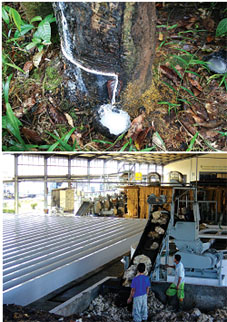 In February, representatives from Thailand, Indonesia and Malaysia who belong to the International Rubber Consortium (IRC) met to discuss solutions to survive the slump in world rubber prices. The three countries - which account for more than 70% of the world誷 natural rubber production - agreed to cut exports by 915,000 tons this year and would not sell rubber at below $1.35 per kilogram. Thailand, which exports 4 million tons annually agreed to stockpile 200,000 tons of rubber from February to stabilize rubber prices. The Thai government also approved a one-year 8 billion Baht ($229 million) scheme to extend interest-free loans to farmers?cooperatives for them to hold back 8% of the rubber they produce for export every year. Its commitment is to cut rubber exports by 130,000 tons in the first quarter of 2009. Malaysia, on the other hand, is expected to reduce its export of rubber to 22,000 tons in the first quarter. With the price of rubber halved from its July 2008 level, rubber producers agreed to cut rubber exports to remain viable this year. The three countries are expected to meet and discuss again how much rubber exports they would cut in the second quarter to achieve the target of paring 915,000 tons in 2009 exports.
In February, representatives from Thailand, Indonesia and Malaysia who belong to the International Rubber Consortium (IRC) met to discuss solutions to survive the slump in world rubber prices. The three countries - which account for more than 70% of the world誷 natural rubber production - agreed to cut exports by 915,000 tons this year and would not sell rubber at below $1.35 per kilogram. Thailand, which exports 4 million tons annually agreed to stockpile 200,000 tons of rubber from February to stabilize rubber prices. The Thai government also approved a one-year 8 billion Baht ($229 million) scheme to extend interest-free loans to farmers?cooperatives for them to hold back 8% of the rubber they produce for export every year. Its commitment is to cut rubber exports by 130,000 tons in the first quarter of 2009. Malaysia, on the other hand, is expected to reduce its export of rubber to 22,000 tons in the first quarter. With the price of rubber halved from its July 2008 level, rubber producers agreed to cut rubber exports to remain viable this year. The three countries are expected to meet and discuss again how much rubber exports they would cut in the second quarter to achieve the target of paring 915,000 tons in 2009 exports. Thailand, Indonesia and Malaysia agreed to cut exports by 915,000 tons this year and would not sell rubber at below $1.35 per kilogram.
Taking its cue from the three major exporters, Vietnam is reducing exports by as much as 200,000 tons this year. Vietnam shipped 645,000 tons - or 97% of its total output - in 2008, down by almost 10% from a year earlier. The Vietnam Rubber Group is seeking a VND1.5 trillion ($85.8 million) loan at a preferential rate from the government to purchase 100,000 tons of rubber from growers for storage before trees are chopped down for other more lucrative crops. While its other neighbors are reducing output, the Philippines is pushing for higher investments in rubber production as it aims to supply one-tenth of the global demand by 2020 - or about 800,000 tons - from the current 1% share. If the target is met, the country is expected to earn $960 million in revenues Expanding production is an expensive venture, however as the Philippines will need to invest at least $5 million to boost rubber production. Of the amount, the government intends to shoulder 60% of the industry's total investment requirement. The area reserved for rubber plantations would also be increased to one million hectares from the current 100,000.New Balance Popular Collection
 iConnectHub
iConnectHub
 Login/Register
Login/Register Supplier Login
Supplier Login


























